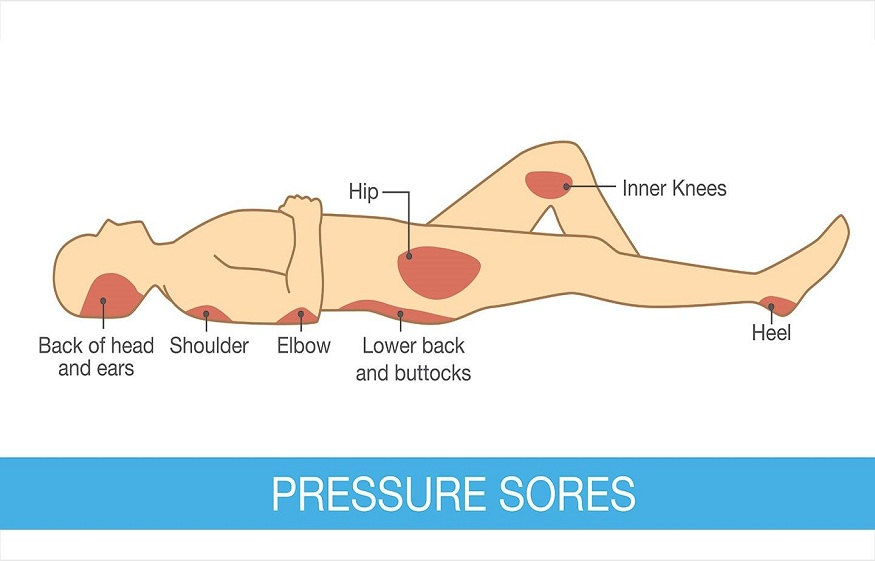Most common nursing intervention for pressure ulcers
A pressure ulcer is a disease characterized by the formation of lesions. These lesions are formed because of the unrelieved pressure which ultimately results in the damage of underlying tissues. A pressure ulcer is also known with other names as well: bedsore, pressure sores, and decubitus ulcers. The severity level of this disease varies from reddening of the skin to the exposure of muscle and bone. This is a dangerous disease that can impair the mobility of the patient in many cases, especially in older patients. It can also lead to neurologic disorder.
Major symptoms of this disease are the destruction of the surface of the skin, pus, and the exposure of internal body parts like muscles and bones. The occurrence of these symptoms indicated the presence of the disease. Then if the disease is left untreated it will lead to stage 1, stage 2, stage 3, stage 4, and stage 5.
It is important to treat the patient on time i.e. in an early stage. Moreover, patients who are at risk of developing pressure ulcers should be treated immediately. As delaying can result in unfortunate conditions. Scientists are working day and night to comprehend the pathophysiology of this disease. Finding a proper and efficient cure would take some time. In the meanwhile, it is important to opt for nursing interventions (are the treatments and measures that are taken to help the patient to reach the goal set for him/her) to treat the disease.
Predisposing factor
It is very important to assess the particular predisposing factor for this ulcer. Finding the risk factor for the patient who is at the risk of developing the disease is very important. Moreover, it is also important to find out the risk factor in those patients who are already suffering from this disease. It is also important to use medical sheepskins to minimize the discomfort. This would help the patients to prevent the development of the next stage. Thus, it is very important to prevent the occurrence or spread of the disease.
Skin condition and age
The nurse should also keep an eye on the condition of the skin and also note the age of the client. As elderly patients are more susceptible to this disease because such patients have less elastic and less moisturized skin. Moreover, the epidermis of elderly people has also become thin. Due to these conditions, a patient whose age greater than 60 years is prone to this disease.
Radiotherapy
It makes the skin brittle and thin. There are also many chances that such skin has very low blood. Thus, as a result, it has more chances of breaking down. So, it is important to note the history of these therapies. If the patient has gone through them then extra care should be done to minimize the chances of skin breakdown.
Other diseases
It is very important to know the history of the patients. The patients who are suffering from other chronic diseases like diabetes, AIDS, heart problem, hip arthroscopy, etc. have a greater tendency of developing pressure ulcers. This is because these patients have many risk factors. Loss of movement, incontinence, poor nutrition, and dehydration also elevate the chances of occurring this ulcer.
Pressure sensation
Due to any unpleasant stimulus, people shift themselves to decrease the pressure. It is a voluntary action. People can do this even in sleep. While patients having these ulcers are unable to sense the presence of pressure which is caused by any stimulus (either internal or external). Hence, due to the absence of any sensation, they do not shift their weight. This lack of sensation leads to the exposure of skin to more pressure resulting in skin breakdown.
Involuntary excretion
Patients who lack the control of excretion tend to suffer from this disease more than those who do not. Such patients use diapers. Feces and urine have enzymes and urea which change into ammonia respectively, cause the skin to break down rapidly. Additionally, these diapers have a plastic covering which traps the moisture and worsens the situation. So, it is very necessary to keep the skin dry and change the diaper frequently.
Movement
Immobilization mostly results in the development of bedsore. Older people are more vulnerable to predisposing factors. It is a very important intervention to check the mobility of the patient regularly.
Diet
The nurse should know about the diet of the patient and should also take great care of the intake of important nutrients as these are important nursing interventions to prevent this disease. If the patient has lost or gained weight then the nurse should have noticed that too. Serum albumin levels should also be known because these patients have typically low protein, as well as serum, levels. Hence to maintain the serum level patients should be given a protein-rich diet.
External moisture
Excessive moisture is not good for patients with pressure ulcers. That is why it is necessary to keep an eye on the environmental moisture content like humidity, wound drainage, sweating, etc.
